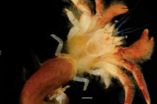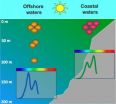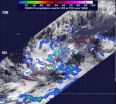(Press-News.org) HOUSTON - Researchers at The University of Texas MD Anderson Cancer Center have tracked down a cancer-promoting protein's pathway into the cell nucleus and discovered how, once there, it fires up a glucose metabolism pathway on which brain tumors thrive.
They also found a vital spot along the protein's journey that can be attacked with a type of drug not yet deployed against glioblastoma multiforme, the most common and lethal form of brain cancer. Published online by Nature Cell Biology, the paper further illuminates the importance of pyruvate kinase M2 (PKM2) in cancer development and progression.
"PKM2 is very active during infancy, when you want rapid cell growth, and eventually it turns off. Tumor cells turn PKM2 back on - it's overexpressed in many types of cancer," said Zhimin Lu, M.D., Ph.D., the paper's senior author and an associate professor in MD Anderson's Department of Neuro-Oncology.
Lu and colleagues showed earlier this year that PKM2 in the nucleus also activates a variety of genes involved in cell division. The latest paper shows how it triggers aerobic glycolysis, processing glucose into energy, also known as the Warburg effect, upon which many types of solid tumors rely to survive and grow.
"PKM2 must get to the nucleus to activate genes involved in cell proliferation and the Warburg effect," Lu said. "If we can keep it out of the nucleus, we can block both of those cancer-promoting pathways. PKM2 could be an Achilles' heel for cancer."
By pinpointing the complicated steps necessary for PKM2 to penetrate the nucleus, Lu and colleagues found a potentially druggable target that could keep the protein locked in the cell's cytoplasm.
MEK, ERK emerge as targets
The process begins when the epidermal growth factor connects to its receptor on the cell surface. This leads to:
Activation of the MEK protein, which in turn activates ERK.
ERK sticking a phosphate group to a specific spot on PKM2.
Phosphorylation priming PKM2 for a series of steps that culminate in its binding to the protein importin, which lives up to its name by taking PKM2 through the nuclear membrane.
Once in the nucleus, the team showed that PKM2 activates two genes crucial to aerobic glycolysis and another that splices PKM RNA to make even more PKM2.
An experiment applying several kinase-inhibiting drugs to human glioblastoma cell lines showed that only a MEK/ERK inhibitor prevented EGF-induced smuggling of PKM2 into the nucleus. ERK activation then is mandatory for PKM2 to get into the nucleus.
"MEK/ERK inhibitors have not been tried yet in glioblastoma multiforme," Lu said. Phosporylated PKM2 is a potential biomarker to identify patients who are candidates for MEK/ERK inhibitors once those drugs are developed.
MEK inhibitor blocks tumor growth
The researchers also found that the two glycolysis genes activated by PKM2, called GLUT1 and LDHA, are required for glucose consumption and conversion of pyruvate to lactate, crucial factors in the Warburg Effect. Depleting PKM2 in tumor cell lines reduced glucose consumption and lactate production.
In mice, depleting PKM2 blocked the growth of brain tumors. Re-expressing the wild type protein caused tumors to grow. However, re-expression of a PKM2 mutant protein that lost its ability to get into the nucleus failed to promote tumor formation. Experiments in human glioblastoma cell lines showed the same effect.
Injecting the MEK inhibitor selumetinib into tumors inhibited tumor growth, reduced ERK phosphorylation, PKM2 expression and lactate production in mice. In 48 human tumor samples, the team found that activity of EGFR, ERK1/2 and PKM2 were strongly correlated.
Cause of PKM2 overexpression
Lu and colleagues also published a paper in Molecular Cell that revealed a mechanism for overexpression of PKM2 in glioblastoma. They found that EGF receptor activation turns on NF-?B, which leads to a series of events culminating in PKM2 gene activation.
PKM2 levels were measured in tumor samples from 55 glioblastoma patients treated with standard of care surgery, radiation and chemotherapy. The 20 with low PKM2 expression had a median survival of 34.5 months, compared to 13.6 months for the 35 patients with high levels of PKM2.
Level of PKM2 expression in 27 low-grade astrocytomas was about half of the expression found in higher grade glioblastomas.
"In these two papers, we show how PKM2 is overexpressed in tumors, how it gets into the nucleus, that nuclear entry is essential to tumor development, and identified potential drugs and a biomarker that could usefully treat people," Lu said.
INFORMATION:
Co-authors of the Nature Cell Biology paper are first author Weiwei Yang, Ph.D., Yanhua Zheng, Ph.D., Yan Xia, Ph.D., and Haitao Ji, Ph.D., of MD Anderson's Department of Neuro-Oncology and Brain Tumor Center; Xiaomin Chen, Ph.D., of MD Anderson's Department of Biochemistry and Molecular Biology; Ken Aldape, M.D., MD Anderson's Department of Pathology; Fang Guo, Ph.D., Nanomedicine Center, Shanghai Research Institute, China Academy of Science; Costas Lyssiotis, Ph.D., and Lewis Cantley, Ph.D., Beth Israel Deaconess Medical Center, Harvard Medical School.
This research was funded by grants from the National Institutes of Health (numbers 2RO1CA109035, RO1GM068566 and RO1GM56302), MD Anderson's Cancer Center Support Grant (CA16672) from the National Cancer Institute; and a research grant from the Cancer Prevention and Research Institute of Texas.
About MD Anderson
The University of Texas MD Anderson Cancer Center in Houston ranks as one of the world's most respected centers focused on cancer patient care, research, education and prevention. MD Anderson is one of only 41 comprehensive cancer centers designated by the National Cancer Institute. For nine of the past 11 years, including 2012, MD Anderson has ranked No. 1 in cancer care in "America's Best Hospitals," a survey published annually in U.S. News & World Report.
Metabolic protein launches sugar feast that nurtures brain tumors
PKM2 slips into nucleus to promote cancer; potential biomarker and drug approach discovered
2012-11-27
ELSE PRESS RELEASES FROM THIS DATE:
American University biologist discovers new crab species
2012-11-27
Areopaguristes tudgei. That's the name of a new species of hermit crab recently discovered on the barrier reef off the coast of Belize by Christopher Tudge, a biology professor at American University in Washington, D.C.
Tudge has been interested in biology his whole life, from boyhood trips to the beach collecting crustaceans in his native Australia, to his undergraduate and PhD work in zoology and biology at the University of Queensland. He has collected specimens all over the world, from Australia to Europe to North and South America.
Until now, he has never had ...
Study links improved consumer welfare to increased prescription drug advertising efforts
2012-11-27
Athens, Ga. – More people are better off thanks to the impact of an influx of direct-to-consumer advertising spending than they would be without those marketing efforts, according to a study recently published by Jayani Jayawardhana, an assistant professor in the University of Georgia College of Public Health.
The multi-year study focused on advertising efforts surrounding cholesterol-reducing prescription medications. Jayawardhana found increased levels of consumer welfare due to direct-to-consumer advertising than when compared to situations without this type of marketing. ...
SwRI team reports Cassini finds a video gamer's paradise at Saturn
2012-11-27
Call it "PAC-MAN, the Sequel." Scientists with NASA's Cassini mission have spotted a second feature shaped like the 1980s video game icon in the Saturn system, this time on the moon Tethys.
The pattern appears in thermal data obtained by Cassini's composite infrared spectrometer, with warmer areas making up the PAC-MAN shape.
"Finding a second PAC-MAN in the Saturn system tells us that the processes creating these 'PAC-MEN' are more widespread than previously thought," said Dr. Carly Howett, the lead author of a recently published paper in the journal Icarus. "The Saturn ...
IU-led team uncovers process for chameleon-like changes in world's most abundant phytoplankton
2012-11-27
An international team of biologists led by Indiana University's David M. Kehoe has identified both the enzyme and molecular mechanism critical for controlling a chameleon-like process that allows one of the world's most abundant ocean phytoplankton, once known as blue-green algae, to maximize light harvesting for photosynthesis.
Responsible for contributing about 20 percent of the total oxygen production on the planet, the cyanobacteria Synechococcus uses its own unique form of a sophisticated response called chromatic acclimation to fine tune the absorption properties ...
Newly insured patients may have trouble finding primary care physicians
2012-11-27
Implementation of the Affordable Care Act – now assured by the re-election of President Obama – is expected to result in up to 50 million currently uninsured Americans acquiring some type of health insurance coverage. But a study by researchers at the Mongan Institute for Health Policy at Massachusetts General Hospital (MGH) finds that a significant percentage of the primary care physicians most likely to care for newly insured patients may be not be accepting new patients. The investigators note that strategies designed to increase and support these "safety-net" physicians ...
UIC scientists find ancient microbes in salty, ice-sealed Antarctic lake
2012-11-27
Shedding light on the limits of life in extreme environments, scientists have discovered abundant and diverse metabolically active bacteria in the brine of an Antarctic lake sealed under more than 65 feet of ice.
The finding, described in this week's issue of the Proceedings of the National Academy of Sciences, is surprising because previous studies indicate that the brine has been isolated from the surface environment -- and external sources of energy -- for at least 2,800 years, according to two of the report's authors, Peter Doran and Fabien Kenig, both professors ...
Cassini finds a video gamers' paradise at Saturn
2012-11-27
You could call this "Pac-Man, the Sequel." Scientists with NASA's Cassini mission have spotted a second feature shaped like the 1980s video game icon in the Saturn system, this time on the moon Tethys. (The first was found on Mimas in 2010). The pattern appears in thermal data obtained by Cassini's composite infrared spectrometer, with warmer areas making up the Pac-Man shape.
"Finding a second Pac-Man in the Saturn system tells us that the processes creating these Pac-Men are more widespread than previously thought," said Carly Howett, the lead author of a paper recently ...
NASA spots heavy rainfall in Tropical Depression 26W threatening Micronesia
2012-11-27
The twenty-sixth tropical cyclone of the western North Pacific Ocean season formed and has some areas of heavy rain, according to data from NASA's TRMM satellite. Tropical Depression 26W is threatening islands within Micronesia and warnings and watches are currently in effect.
Micronesia is a region in the western North Pacific Ocean made up of thousands of small islands. West of the region is the Philippines, while Indonesia is located to the southwest.
NASA's Tropical Rainfall Measuring Mission (TRMM) satellite passed over Tropical Depression 26W on Nov. 26 at 0526 ...
Scatter radiation from mammography presents no cancer risk
2012-11-27
CHICAGO – The radiation dose to areas of the body near the breast during mammography is negligible, or very low, and does not result in an increased risk of cancer, according to a study presented today at the annual meeting of the Radiological Society of North America (RSNA). The results suggest that the use of thyroid shields during mammography is unnecessary.
"Thyroid shields can impede good mammographic quality and, therefore, are not recommended during mammography," said Alison L. Chetlen, D.O., assistant professor of radiology at Penn State Hershey Medical Center.
During ...
Radiologic and physical findings identify elder abuse
2012-11-27
CHICAGO – Radiologists in Toronto have begun to identify a pattern of injuries that may be indicative of elder abuse, according to a study presented today at the annual meeting of the Radiological Society of North America (RSNA).
According to lead researcher Kieran J. Murphy, M.D., F.R.C.P.C., F.S.I.R., interim radiologist-in-chief at University Health Network in Toronto, Canada, only 2 percent of physical elder abuse is reported by clinicians.
"Unlike cases of child abuse, there is very little information available on this subject," Dr. Murphy said. "It's a much ...
LAST 30 PRESS RELEASES:
Membrane magic: FAMU-FSU researchers repurpose fuel cells membranes for new applications
UN Member States pledge to increase access to diagnosis and inhaled medicines for the 480 million people living with COPD
Combination therapy shows potential to treat pediatric brain cancer ATRT
Study links seabird nesting to shark turf wars in Hawai‘i
Legal sports betting linked to sharp increases in violent crime, study finds
Breakthrough AI from NYUAD speeds up discovery of life-supporting microbes
New Eva Mayr-Stihl Foundation funding initiative boosts research at University of Freiburg on adaptation of forests to global change
The perfect plastic? Plant-based, fully saltwater degradable, zero microplastics
Bias in data may be blocking AI’s potential to combat antibiotic resistance
Article-level metrics would provide more recognition to most researchers than journal-level metrics
Satiety’s little helper: Protein that supports appetite regulating protein identified
UF dives deep into predicting storm damage with computer models
A stormy ocean voyage yields insights on the global carbon cycle
Scientists identify first non-coding gene that controls cell size
Demonstration of altermagnetism in RuO₂ thin films -- A new magnetic material for the AI era
Penn researchers awarded $25M to conduct trial using smartphones to fight heart disease
PCORI awards funding for new patient-centered healthcare research
Exploring the origins of the universe: 145 low-noise amplifiers complete ALMA telescopes
Empress cicada wings help illuminate molecular structure
Using sound waves to detect helium
Time burden in patients with metastatic breast and ovarian cancer from clinic and home demands
Researchers discover bias in AI models that analyze pathology samples
Scientists ID potential way to prevent brain injuries from triggering Alzheimer's
MASTER 2nd Open Call: Execution period kick-off
Algae for health in food and pharma
Advanced microrobots driven by acoustic and magnetic fields for biomedical applications
Chicago health information leader recognized for raising CPR readiness and blood pressure awareness
The Intimate Animal, a new book from Kinsey Institute Executive Director Dr. Justin Garcia
When blue-collar workers lose union protection, they try self-employment
New video dataset to advance AI for health care
[Press-News.org] Metabolic protein launches sugar feast that nurtures brain tumorsPKM2 slips into nucleus to promote cancer; potential biomarker and drug approach discovered




